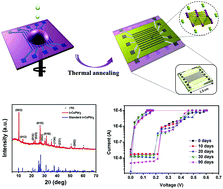Solution-processed inorganic δ-phase CsPbI3 electronic synapses with short- and long-term plasticity in a crossbar array structure†
Abstract
Electronic synapses based on memristive devices can potentially open a niche area for neuromorphic computing by replicating the function of biological synapses with high fidelity. Recently, two-terminal memristors based on halide perovskites have demonstrated outstanding memristive properties and a variety of synaptic characteristics, combining with their additional advantages such as a solution-processed fabrication method and low crystalline temperature. However, the concerns over the chemical and phase stability of halide perovskites greatly hinder their practical applications. In this study, by using a simple single-step spin-coating method, we report artificial synapses with superior ambient stability (>90 days under ambient conditions) based on fully inorganic nonperovskite δ-phase CsPbI3 in a cross-bar array architecture. The threshold switching memristive device exhibits a moderate ON/OFF ratio, a relatively low operation voltage (0.3 V) and high endurance (>5 × 105). More importantly, the electronic device can emulate synaptic characteristics such as short-term plasticity, paired-pulse facilitation, and the transition from short-term memory to long-term memory with a high output signal-to-noise ratio (>102). This work represents the first record for artificial synapses based on nonperovskite CsPbI3 and will be a step toward achieving low-cost and high-density practical synapse arrays.



 Please wait while we load your content...
Please wait while we load your content...